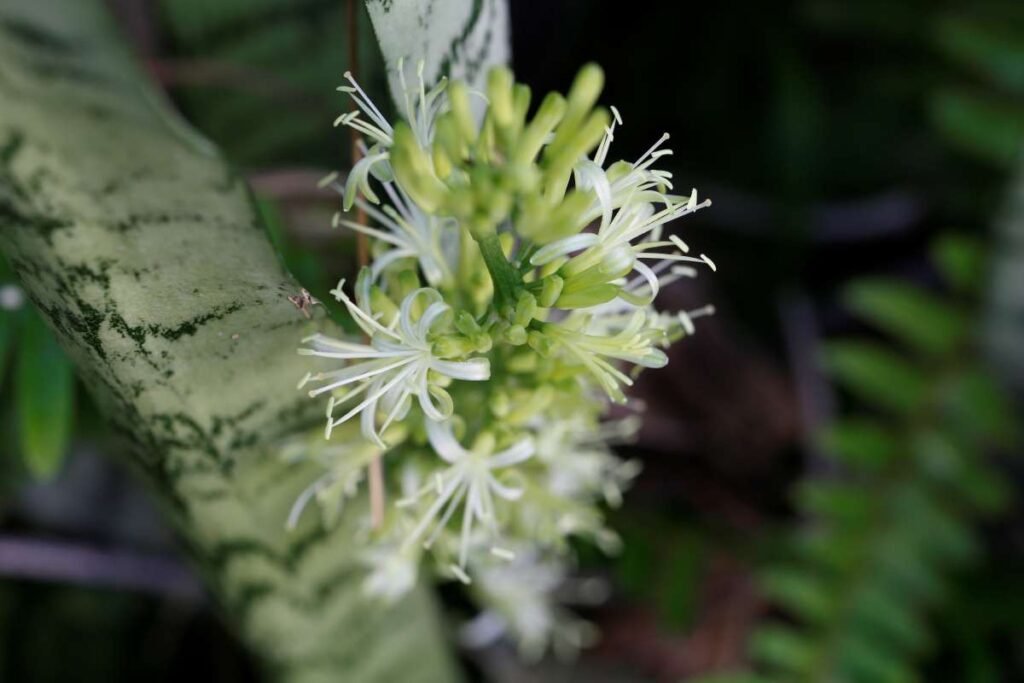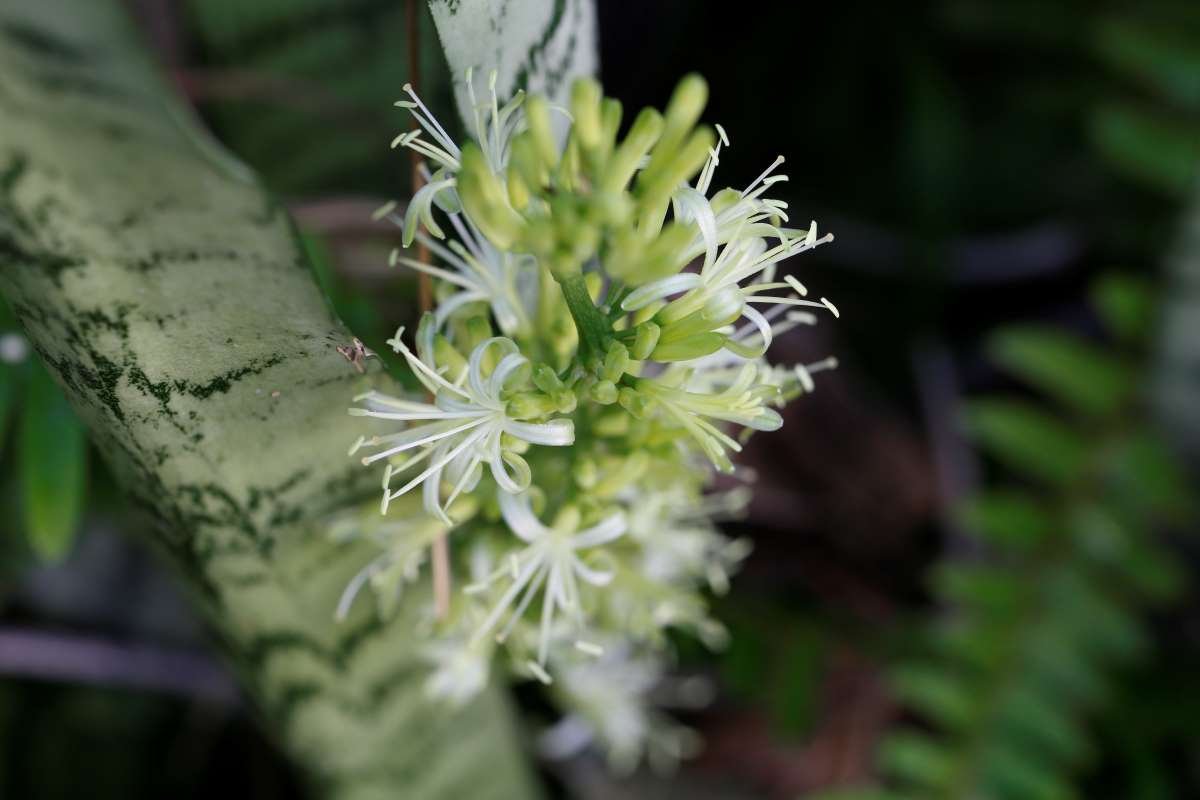Snake plants, known scientifically as Sansevieria or Dracaena trifasciata, are among the most popular houseplants, appreciated for their hardiness, air-purifying qualities, and minimal care needs.
Also referred to as “Mother-in-law’s tongue” due to their long, sword-like leaves, they are beloved by both beginner and experienced plant enthusiasts.
One of the lesser-known facts about these resilient plants, however, is that they can actually bloom, producing flowers under certain conditions.
This article will take an in-depth look at the snake plant flower, exploring everything from its biology to the factors that promote flowering, the plant’s role in cultural symbolism, and practical tips for snake plant care.
By the end of this post, you’ll have a comprehensive understanding of this rare but beautiful occurrence and how to potentially encourage your own snake plant to bloom.
Table of Contents
The Basics of Snake Plants
Before diving into the flowering phenomenon, let’s start by understanding the basics of the snake plant.
Appearance and Varieties
Snake plants are characterized by their stiff, upright leaves that can grow anywhere from a few inches to several feet tall. The leaves are often variegated with green and yellow stripes or edges.
The most common variety is Dracaena trifasciata, but there are numerous cultivars, each with unique patterns, colors, and leaf shapes.
Some popular varieties include:
- Sansevieria laurentii: Recognized for its tall, upright leaves with yellow borders.
- Sansevieria cylindrica: Features cylindrical, tube-like leaves that fan outward.
- Sansevieria moonshine: Known for its pale, silver-green leaves, offering a modern, minimalist look.
Although snake plants are prized for their foliage, their ability to produce flowers is an interesting and lesser-known aspect of their lifecycle.

The Rare Phenomenon of Snake Plant Flowering
The most remarkable feature of the snake plant flower is its rarity. Many snake plant owners may never witness their plant bloom in their lifetime.
Snake plants can bloom under very specific conditions, and the flowers are a delicate, fragrant surprise when they do.
What Do Snake Plant Flowers Look Like?
When a snake plant decides to flower, it sends out a tall stalk, or inflorescence, which can grow up to several feet in height.
This stalk is adorned with clusters of small, tubular, white or greenish-white flowers. These flowers are quite fragrant, especially during the night, emitting a sweet, almost jasmine-like scent.
Each individual flower opens slowly, beginning with the lower blooms and progressing upwards over time.
The flowers are star-shaped with long, slender petals, giving them an elegant appearance. Some snake plant flowers also produce a sticky, nectar-like substance, which can be seen as small droplets on the petals.
Why Is Flowering So Rare?
The flowering of a snake plant is a rare event primarily because it is triggered by environmental stress factors rather than regular care practices.
This phenomenon is a survival strategy. When a plant is under stress, it tries to reproduce by flowering and creating seeds, ensuring the survival of its species.
When Do Snake Plants Bloom?
Snake plants are more likely to bloom when they are slightly neglected. This means that plants grown in less-than-ideal conditions, such as being slightly root-bound, not repotted for years, or placed in low-light environments, have a higher chance of flowering.
It is often said that a snake plant flowers when it thinks it’s dying or when it reaches a point of maturity. However, this does not mean the plant is unhealthy; rather, it has adapted to cope with stress by reproducing.
Flowering typically occurs in the spring or summer, but this can vary depending on the specific conditions the plant experiences.
It’s worth noting that a snake plant can flower multiple times throughout its life, but there is no set schedule for when or how often this will happen.
Factors That Influence Snake Plant Flowering
Age and Maturity
A snake plant needs to reach a certain level of maturity before it is capable of flowering. While the exact age can vary depending on growing conditions and plant variety, it typically takes several years before a snake plant is old enough to bloom. Some snake plants may not flower until they are 5 to 10 years old.
Stress and Neglect
As mentioned earlier, stress is a significant factor in encouraging a snake plant to flower. This doesn’t mean you should intentionally mistreat your plant, but a certain level of “benign neglect” can promote flowering.
Snake plants that are slightly root-bound (i.e., their roots have outgrown their pot) are more likely to flower. Additionally, infrequent watering or slightly reduced light conditions can increase the chances of blooming.
Light Conditions
While snake plants can survive in low-light environments, they prefer indirect, bright light to thrive. However, exposure to too much sunlight can cause stress and increase the chance of blooming.
Snake plants exposed to natural sunlight or artificial grow lights that simulate full-spectrum daylight are more likely to flower than those kept in darker areas.
Watering Habits
Snake plants are incredibly drought-tolerant, but overwatering can be detrimental to their health. To encourage flowering, it’s important to let the soil dry out between waterings.
Erratic watering schedules, where the plant goes through prolonged dry periods followed by deep watering, can mimic the natural cycles of stress that trigger flowering.
Temperature and Humidity
Snake plants are native to the arid regions of West Africa, which means they are accustomed to hot temperatures and low humidity.
These plants thrive in temperatures between 60°F and 85°F (15°C to 29°C), and exposing them to these conditions can increase the likelihood of flowering. Cold temperatures or sudden temperature fluctuations, on the other hand, can inhibit blooming.
Snake Plant Flowering: Myths vs. Reality
There are several myths surrounding the snake plant flower, and understanding the truth behind these can help dispel common misconceptions.
Myth 1: Snake Plants Die After Flowering
This myth is rooted in the belief that snake plants, like some monocarpic plants (such as agave), die after producing flowers.
However, this is not true for snake plants. After flowering, the plant continues to grow and thrive. In fact, a snake plant can flower multiple times throughout its life without any negative effects on its health.
Myth 2: Flowering Is a Sign of Poor Health
While it’s true that stress can trigger flowering, this does not mean that the plant is in poor health. A flowering snake plant is often an indication of maturity and adaptability, not sickness.
The plant has simply reached a point in its lifecycle where it’s able to reproduce.
Myth 3: Snake Plant Flowers Are Poisonous
Snake plants are mildly toxic to pets and humans if ingested, but the flowers themselves are not dangerous to touch or smell.
It’s always a good idea to keep the plant out of reach of pets and children, but simply enjoying the fragrance and appearance of the flowers poses no harm.
The Biology of Snake Plant Flowers
Reproductive Strategy
Like most flowering plants, snake plants reproduce through both sexual and asexual means. The flowers contain both male and female reproductive organs, allowing for self-pollination or cross-pollination by insects.
The plant’s primary method of reproduction, however, is vegetative propagation through its rhizomes. This means the plant spreads by producing new shoots from its underground root system.
While the flowers can produce seeds, snake plant seeds are rarely viable or used in propagation. Most snake plant owners prefer to propagate their plants by dividing the rhizomes or taking leaf cuttings.
Pollination and Seed Production
Snake plant flowers are pollinated by insects, especially moths, which are attracted to the flowers’ sweet fragrance. If pollination is successful, the flowers will develop small, berry-like fruits containing seeds.
However, it’s important to note that seed propagation is not common for snake plants, and most growers rely on vegetative methods to propagate new plants.
Nectar Production
One of the fascinating features of snake plant flowers is their ability to produce nectar. The flowers exude small droplets of a sticky, sugary substance, which attracts pollinators.
This nectar is harmless to humans and can be wiped away if it becomes too sticky, but it adds to the overall allure of the flowering process.
Caring for a Flowering Snake Plant
Once a snake plant has begun to flower, there are a few steps you can take to ensure the plant remains healthy throughout the process.
Watering
Continue to water the plant as usual, allowing the soil to dry out between waterings. Avoid overwatering, as this can lead to root rot, especially when the plant is focused on producing flowers.
Light
Keep the plant in bright, indirect light to support flower development. Avoid placing it in direct sunlight, as this can scorch the leaves and flowers.
Fertilizing
Snake plants don’t require much fertilization, but a light feeding of a balanced, water-soluble fertilizer can help support the plant’s energy needs during the flowering process. Fertilize once a month during the growing season (spring and summer) and reduce or stop fertilization during the fall and winter.
Pruning
Once the flowers have finished blooming, you can cut back the flower stalk to the base of the plant. This will help the plant focus its energy on leaf growth rather than seed production.
Propagation of Snake Plants
While flowering is an exciting event, most snake plant owners are more interested in propagating their plants for new growth.
Fortunately, snake plants are incredibly easy to propagate through several methods:
1. Rhizome Division
The most common method of propagation is dividing the plant’s rhizomes. Rhizomes are the underground stems that snake plants use to spread.
To propagate by division, carefully remove the plant from its pot and gently separate the rhizomes, ensuring each section has at least one healthy leaf and root system. Replant the divisions in separate pots with fresh soil.
2. Leaf Cuttings
Another method is to take leaf cuttings. To do this, cut a healthy leaf into 2- to 4-inch sections and plant them in moist soil.
Over time, the cuttings will develop roots and new shoots. This method requires patience, as it can take several weeks to months for new growth to appear.
3. Water Propagation
Snake plant leaves can also be propagated in water. Place a leaf cutting in a jar of water, making sure the cut end is submerged.
After a few weeks, roots will begin to form, and once they are well-established, the cutting can be transferred to soil.
The Symbolism and Cultural Significance of Snake Plants
Beyond their physical characteristics, snake plants hold symbolic meaning in various cultures.
Feng Shui and Positive Energy
In Feng Shui, snake plants are considered symbols of good luck and prosperity. Their upright, sword-like leaves are believed to cut through negative energy and promote protection and strength.
It’s common to see snake plants placed near entrances or in offices to encourage positive energy flow.
African Folklore
Native to West Africa, snake plants have also been revered in African folklore for their resilience and protective qualities. Some cultures believe that keeping a snake plant in the home can ward off evil spirits.
Modern Symbolism
Today, snake plants are often associated with endurance, longevity, and adaptability due to their ability to thrive in tough conditions. They’ve become symbols of resilience and self-sufficiency in the world of houseplants.
Conclusion
The snake plant flower is a rare and beautiful occurrence that adds a fascinating dimension to this already popular houseplant.
While flowering is not guaranteed, understanding the conditions that promote blooming can enhance your experience as a snake plant owner.
Whether your snake plant flowers or not, it will continue to be a valuable addition to your home, offering both aesthetic appeal and air-purifying benefits.
By embracing the natural lifecycle of your snake plant and providing it with the right balance of care and stress, you may one day be rewarded with the delightful sight and scent of snake plant flowers.
Whether you’re a seasoned plant enthusiast or a beginner, the snake plant’s resilience, beauty, and rare flowering capability make it an intriguing and rewarding addition to any indoor garden.

